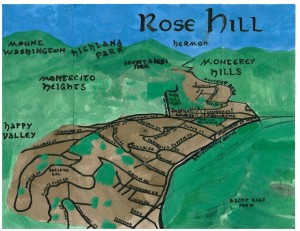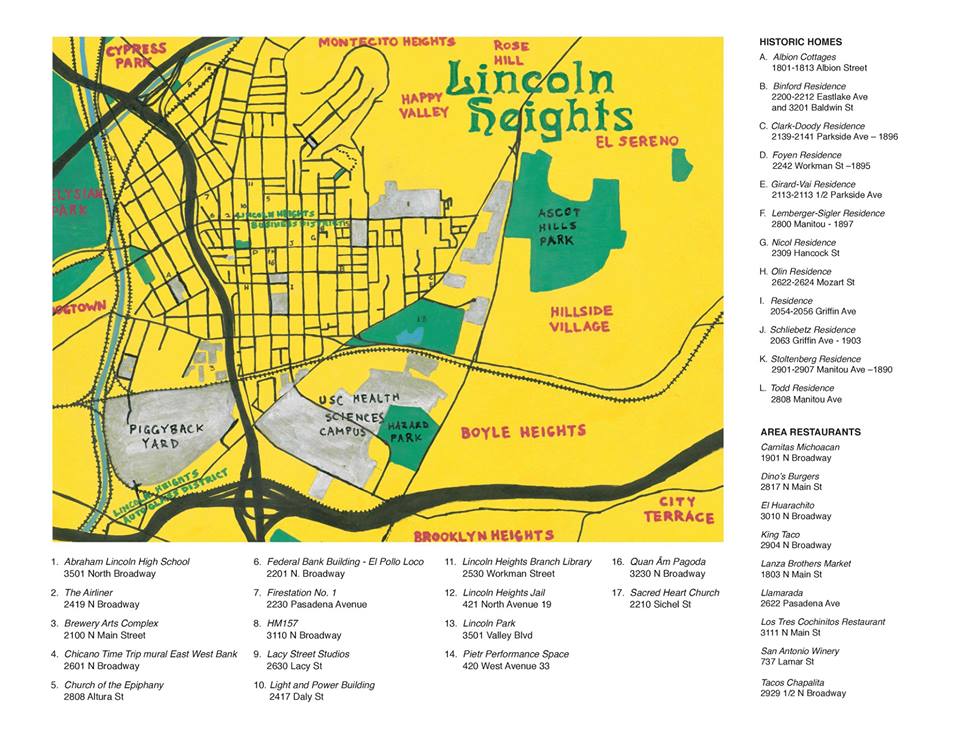By Eric Brightwell
A few years ago my aging but until-then-reliable Subaru blew a head gasket deep in the Mojave Desert, choosing like all of its predecessors to break down in the least convenient of places. Rather than repair it, I sold it for scrap (which didn’t recoup the towing costs) and decided to go car-free, something I’d previously dabbled with for months at a time but never committed fully to.
By the time of my decision I’d been writing about exploring Los Angeles neighborhoods for Amoeba Music’s Amoeblog for a few years. That, in turn, had led to doing similar work for KCET—apparently some people enjoyed reading about walking and exploring almost as much as I enjoy doing it…or maybe they just liked the maps that I drew which accompanied the writing. Maps go hand in hand (or foot in foot) with rambles and my crudely drawn and painted ones have amused some.
In exploring on foot (and bike, train, and bus) I noticed that I’d gotten more fit, was feeling better, and best of all, experiencing the city (Los Angeles, in my case, where we’re told car is king and no one walks) on a much deeper and fulfilling level than I ever had during the years I’d wasted trapped within my metal box, practically entombed between freeway noise barriers to the sad tune of thousands of dollars in annual operating costs.
In popular culture, cars are sexy symbols of freedom. In school the requirement to take Driver’s Ed (and non-existence of Transit Rider’s Ed) prepares us for an unhealthy addiction to automobiles. More and more people, whose childhoods were spent in freeway gridlock, are choosing to walk away from cars. Even if you choose to own a car (or boat, plane, dirigible, hot air balloon or other expensive toy), walking even occasionally can have very real benefits on your well-being and wallet. Although most of us pick up the ability to walk in infancy, there are still skills that I’ve learned as an adult:
3. Ramble. If you have time, wander aimlessly. Favor side streets – especially ones blessed with ample shade, parks, or visual appeal. Let all of your senses guide you. Unfamiliar neighborhoods can be the most rewarding although walking through ones you’ve only driven through previously can be eye-opening and stereotype-destroying. Relish your freedom as a pedestrian to go places that cars can’t. Take tunnels, public stairways, walkways, and cut through malls, parks, and cemeteries and the like.
 4. Bring a smartphone. Just because walking is low-tech doesn’t mean that you have to forsake technology. Sites like Foursquare, Yelp, and Urbanspoon are helpful for cluing you into points of interest that are beyond your field of vision. You’ll also want to take pictures to document your adventures. Bring a charger for you phone, too, and keep your eyes open for outlets—they’re perhaps more common than you think—until your batteries at 3%, when they all mysteriously vanish. In any case, a map can help too — I draw my own — because you may not always get reception.5. Talk to strangers. If you look like an outsider, people will often ask what you’re doing. Sometimes they’ll want to show and tell. I’ve been offered rides (which I haven’t taken), water (always appreciated), into people’s homes, a tour of a mausoleum, and most recently – a packet of seed corn. Other times people have just wanted to show me their puppies and swap stories.6. Don’t be afraid. In all likelihood, nothing bad is going to happen to you anywhere. If it makes you feel better though bring (according to your fears) bug spray, bandages (for blisters), pepper spray, mace, keys, hand sanitizer, a dog, or a friend. I always carry a pocket knife. I’ve only ever used it to take cuttings of succulents and flowers but I’ve never wished that I hadn’t had it on me.
4. Bring a smartphone. Just because walking is low-tech doesn’t mean that you have to forsake technology. Sites like Foursquare, Yelp, and Urbanspoon are helpful for cluing you into points of interest that are beyond your field of vision. You’ll also want to take pictures to document your adventures. Bring a charger for you phone, too, and keep your eyes open for outlets—they’re perhaps more common than you think—until your batteries at 3%, when they all mysteriously vanish. In any case, a map can help too — I draw my own — because you may not always get reception.5. Talk to strangers. If you look like an outsider, people will often ask what you’re doing. Sometimes they’ll want to show and tell. I’ve been offered rides (which I haven’t taken), water (always appreciated), into people’s homes, a tour of a mausoleum, and most recently – a packet of seed corn. Other times people have just wanted to show me their puppies and swap stories.6. Don’t be afraid. In all likelihood, nothing bad is going to happen to you anywhere. If it makes you feel better though bring (according to your fears) bug spray, bandages (for blisters), pepper spray, mace, keys, hand sanitizer, a dog, or a friend. I always carry a pocket knife. I’ve only ever used it to take cuttings of succulents and flowers but I’ve never wished that I hadn’t had it on me.
7. Ignore the naysayers. Some people will tell you that no one walks, that it’s impossible to get anywhere on foot, or that it’s dangerous. These people are unfailingly unhealthy and unhappily car-dependent and therefore much more likely to die of heart disease than you are to encounter any sort of unforeseen obstacle. Your walking is something they resent because it, not car-dependency, is real freedom. I can only speak for myself but I’m always surprised at how much closer everything is once I walk than I imagined it to be beforehand.
Helpful websites:
Iain Sinclair
Los Angeles Walks
Walk Score
Big Map Blog
A Walker in L.A.
Walking in L.A.
 About Eric: Eric Brightwell writes Eric’s Blog for Amoeba Music and Block By Block for KCET, both of which frequently revolve around walking explorations. He draws and paints maps of his explorations as Pendersleigh & Sons Cartography. He can frequently be seen walking and reading, and occasionally tripping, around Silver Lake.
About Eric: Eric Brightwell writes Eric’s Blog for Amoeba Music and Block By Block for KCET, both of which frequently revolve around walking explorations. He draws and paints maps of his explorations as Pendersleigh & Sons Cartography. He can frequently be seen walking and reading, and occasionally tripping, around Silver Lake.




